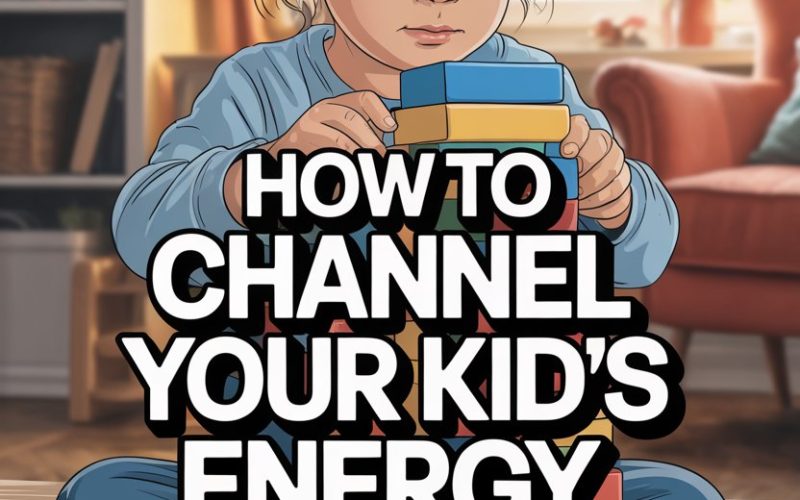Ever found yourself eyeing your child and wondering: “If only I could bottle that energy, Starbucks would be out of business”? You’re not alone.
Kids come with enough zip to power a small city, and it’s not always easy to redirect that spark into something less… sofa-bouncey.
Lucky for parents everywhere, science and a bit of wit can help steer your child’s turbo-charged spirit toward something a little more focused.
Accept That Energy Isn’t the Enemy
Before plotting out any grand plans to make your child act more like a mini-Buddha, it helps to remember: energy isn’t the problem. In fact, researchers like those at Harvard point out that physical activity is linked to better cognitive skills and behaviour in children.
Active kids are primed for learning—just not always in the way we picture. Instead of wishing the energy away, it pays to see it as the raw material waiting to be shaped.
Structure is Your Secret Weapon
Picture energy as water: without a tub, it floods the bathroom. Children thrive when there’s a clear outline to their days.
Routines help them know what’s expected, and when they have a sense of what’s coming up, those bursts of excitement are easier to manage.
It doesn’t need to be military-level strictness—think more along the lines of “after breakfast, we read together,” or “before supper, everyone helps tidy the toys.” Predictability doesn’t sound glamorous, but it’s a parent’s best mate.
Movement Breaks Aren’t Just Nice, They’re Necessary
Expecting a child to sit still for hours is a bit like asking a cat to take up knitting—it’s not going to end well. Instead, channel that energy into short, planned movement breaks.
The Pomodoro technique, popular among adults for work focus, works just as beautifully for kids: 20 minutes of concentration, followed by five minutes of movement.
Even a quick dance party in the living room or a round of star jumps can work wonders. According to this study from the CDC, regular movement helps children concentrate better and behave more positively.
Make Focus a Game, Not a Drill
Nothing gets a child’s attention like a challenge. Turning tasks into games gives children a reason to engage those busy minds. “How many red blocks can you find in two minutes?” or “Can you beat the timer and get dressed before I finish singing the alphabet?”
Suddenly, what was once a chore becomes a mission, and kids are all in.
For older children, apps like Forest (plant a tree by not touching the phone), or Habitica (gamify your to-dos) can add extra layers of fun to staying on task. Just don’t be surprised if you end up setting a timer for yourself, too.
Don’t Underestimate the Power of Choice
A sense of autonomy can make even the most stubborn pint-sized negotiator more cooperative. Instead of barking orders, offer options: “Would you like to do your reading in the teepee or at the kitchen table?” “Do you want to start with maths or drawing?”
These little decisions hand ownership over to your child, making it more likely they’ll stick with it. Psychologist William Stixrud notes that children who feel a sense of control are more engaged and less stressed—a win-win for everyone.
Adjust the Environment
Sometimes, the problem isn’t the child’s energy—it’s the space. Open-plan rooms might seem ideal, but they can be disastrous for attention spans.
If you can, set up a dedicated “focus zone” free from distractions like TV, noisy siblings, or the dog’s latest squeaky toy. Even a makeshift nook with a few cushions will help.
Some kids find background music (classical or nature sounds, nothing with lyrics) helps them tune out distractions. For others, silence is golden. Trial and error is your friend here.
Break Big Tasks Into Bite-Sized Bits
A ten-year-old asked to “clean your room” may be paralysed by the sheer scale of the job.
Give them smaller, do-able steps: “Let’s put all your books on the shelf,” then “Now let’s see how many socks you can find.” Momentum builds, and that mountain becomes a series of manageable molehills.
This scaffolding approach is backed by child development experts, who suggest one instruction at a time—especially for younger kids.
Fuel That Body, Fuel That Brain
Energy that seems wild can sometimes be traced back to a blood-sugar rollercoaster. Regular, balanced snacks keep brains and bodies humming along.
Reach for protein, fibre, and healthy fats: apple slices with peanut butter, yoghurt and berries, or a banana and a handful of nuts. Sugary “treats” promise a quick boost, but the crash is never worth it.
Hydration matters, too—sometimes the “ants in the pants” feeling is just thirst in disguise.
Mindful Moments: Not Just for Grown-Ups
Mindfulness is not about getting kids to sit cross-legged and chant “om” (though if you can manage it, please send proof).
Even a few deep breaths or a short “listening game”—close your eyes and see how many sounds you notice—can help kids become more aware of their bodies and surroundings.
Practices like these, according to Child Mind Institute, can improve self-regulation and focus. Many teachers swear by “mindful minute” timers—a gentle bell or chime can cue the whole family to pause and just breathe.
Hobbies That Harness Energy
Some children need a physical outlet before they can settle. Sports, dance, martial arts, or even a brisk walk around the block can burn off the extra fizz.
Artistic pursuits—painting, building Lego masterpieces, learning an instrument—require focus and provide natural boundaries. The trick isn’t to over-schedule every minute, though.
Downtime is crucial too. Sometimes, staring out the window is the best preparation for productivity.
Model What You Want to See
Nothing gets past kids. If your mobile is always in hand, or you’re answering emails at the dinner table, don’t be shocked when your child’s attention wanders.
Model focused behaviour: put your own devices away during important conversations, read a book, or finish a task from start to finish. Children are natural mimics, and actions often speak louder than any pep talk.
The Magic of Encouragement Over Criticism
Step into any home, and you’ll quickly spot the difference between a “Don’t do that!” and a “Wow, I love how you’re sitting so still!” Praise the behaviours you want to see.
Research on positive reinforcement (like this study from the University of Kansas) shows that specific, positive feedback is much more effective than nagging.
Keep it genuine, keep it specific (“You really focused on your drawing for ten minutes—that’s brilliant!”), and watch motivation grow.
When It’s More Than Just Energy
Sometimes, no matter what you try, your child’s impulses seem beyond the usual range of “lively.” If focus issues persist across settings—school, home, playdates—it might be worth chatting with your GP or a paediatrician.
Conditions like ADHD aren’t caused by bad parenting or “too much sugar,” but they can make traditional approaches less effective. Early support makes a world of difference. No shame, just solutions.
Making Focus Fit Your Family
Finding ways to channel your child’s abundant energy isn’t about squashing their spirit, but shaping it.
With a few tweaks—structured routines, movement breaks, clever games, and encouragement—children can learn to harness their natural zest for life.
That same spark, when nurtured, leads to creativity, resilience, and a whole lot more fun (and fewer broken lamps).
Cheers to raising energetic, focused kids—just don’t expect the dog to cooperate.





